A look at attraction-related record albums around the time the world’s number one vacation destination first opened.
Many recognized Mary Poppins as the ultimate combination of everything Walt Disney could achieve on the motion picture screen. It has several connections to the “Florida Project,” as it was called in the early planning stages, from the Audio-Animatronics robin on Julie Andrews’ fingers to the fact that MAPO, a company created with box office profits from the film, helped finance the land purchase and construction.
Walt Disney World Resort was also the culmination of everything Walt Disney had planned and dreamed of from his early days until his passing. Even though he did not see it open, his brother Roy was able to make it happen in his usual masterful way, just as he had done with other impossible projects during their years together. Yet the destination in Central Florida has become such a part of reality for so long, it can be easy to magnitude is easily taken for granted. There are even some who barely understand the scope of what exists there and how much it means to the Walt Disney Company.
When the Magic Kingdom Park opened in 1971, to most of the public it was “Disney World.” The train station sign over the Mickey Mouse face garden read “Walt Disney World” before it was changed to read “Magic Kingdom.” (Disneyland Park in California has also been referred to since 1955 as Walt Disney’s “Magic Kingdom,” although the Florida version uses the trademarked name of “Magic Kingdom Park.”)
It was Julie Andrews (singing “When You Wish Upon a Star”) who co-starred in the Walt Disney World Grand Opening Special, along with Jonathan Winters, Buddy Hackett, Glen Campbell and Annette. The show was sponsored by the resort’s in-park sponsors, GAF film products, Eastern Airlines (sponsor of the beloved “If You Had Wings” attraction with the voice of Orson Welles) and U.S. Steel, which presented commercials showing how they used modular construction to build Disney’s Contemporary Resort.
Magic Kingdom Park sits at the very south end of the Disney property because Walt Disney wanted guests to pass the other Disney offerings that would soon be built before getting there. The property would encompass his dream of Epcot, a city of the future that would be a living example of better ways that people and businesses could improve the world.
Walt also wanted the outside world to fade away as people traveled further into the property and closer to the parks and hotels. While the resort is much more built-up today, it is still too far for to walk from the outskirts of the property to any of the four theme parks–unless you are running in a Walt Disney World Marathon (as your humble author has, and that is very cool to do especially back when the animators worked at the studio and they held up hand-drawn character signs to cheer us along the studio route).
On the south panel of the Magic Kingdom Emporium, signs facing Town Square that now says “Emporium,” used to proclaim some of the store’s wares, including “records.” Even though the store is still themed to the turn of the nineteenth to twentieth centuries (the dawn of the gramophone era) today’s Emporium sells as many records as high-button shoes (perhaps sparing Disney Cast Members the question, “Why don’t you have any records when the sign says you do?”)
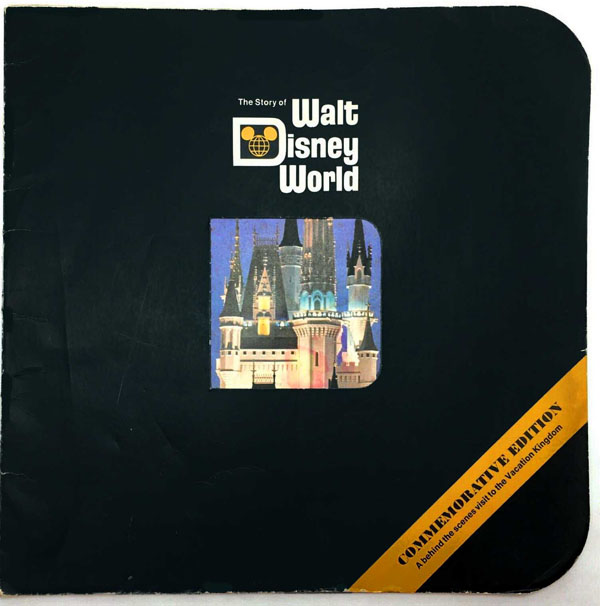
On opening day, October 1st, 1971, a large selection of Disneyland and Buena Vista LP records, Storyteller albums and read-alongs gleamed on the polished wood shelves alongside Big and Little Golden Books. There were also some souvenir books and maps also found in other park shops. (One of my first purchases was The Story of Walt Disney World Commemorative, a paperback, almost the size of an album cover and shaped like a “D,” easily the most thorough history of the resort readily in the shops.)
Fifty years later, a much more elaborate hardcover book-tacular has arrived called A Portrait of Walt Disney World: 50 Years of the Most Magical Place on Earth, a labor of love by Steven Vagnini of Walt Disney Imagineering (and formerly The Walt Disney Archives); Tim O’Day (of the Hyperion Historical Alliance) and Kevin Kern (of The Walt Disney Archives). It offers the history all in one place, sets a lot of stories straight, and contains lots of “I did not know that” facts.
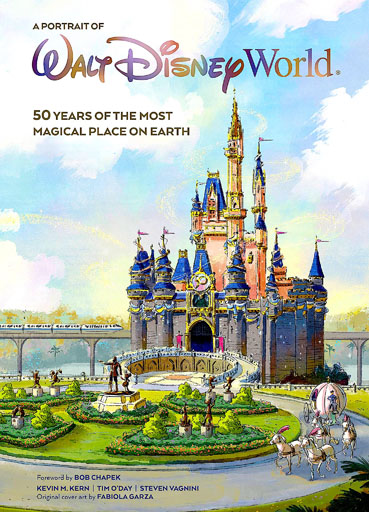
Disneyland/Vista Records President Jimmy Johnson had a direct influence on at least one of the premiere Walt Disney World attractions (more about that in a moment). He likely took great interest in the records being sold in the park and resort locations as well. Besides the Emporium, one could find records at Mickey’s Mart (now Mickey’s Star Traders) in Tomorrowland, Village Gifts and Sundries (now Trader Jack’s) at Disney’s Polynesian Resort; and the Fantasia shop in Disney’s Contemporary Resort (thanks to www.waltdatedworld.com).
Some of the records found within the first few years were recent catalog additions: Annette Funicello (a “best-of” collection); Selections from Fantasia and the Camarata version of Bedknobs and Broomsticks. Longtime sellers like Camarata and Darlene Gillespie’s Alice in Wonderland (the greatest record ever made); Walt Disney’s Most Beloved Songs, soundtracks of Sleeping Beauty and Mary Poppins; and storytellers of Sleeping Beauty, Mary Poppins and Peter Pan. (Bedknobs and Broomsticks, incidentally, was the first Disney feature depicted in three-dimensions diorama Emporium windows.
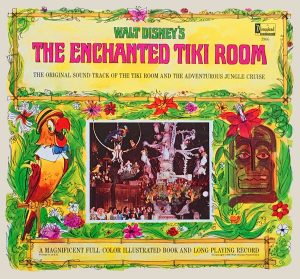 Because Magic Kingdom shared some similar attractions with Disneyland, collectors found carryover albums and some read-along records of The Haunted Mansion, The Enchanted Tiki Room/Jungle Cruise and it’s a small world.
Because Magic Kingdom shared some similar attractions with Disneyland, collectors found carryover albums and some read-along records of The Haunted Mansion, The Enchanted Tiki Room/Jungle Cruise and it’s a small world.
Some attractions originated in Florida and reappeared either in virtual duplicate or modified versions at Disneyland and in other Disney parks as they began to appear throughout the world. Walt Disney World originals include Buzz Lightyear’s Space Ranger Spin, The Twilight Zone Tower of Terror; The Many Adventures of Winnie the Pooh; Muppet*Vision 3-D and most recently, Mickey’s Runaway Railway. One of the most popular to originate at Walt Disney World is Space Mountain.
Lucie Arnaz was delighted to reminisce about the making of the Space Mountain grand opening episode of The Wonderful World of Disney, the second network special produced at Walt Disney World Resort. One of the funny stories she told about the show was about her parody of the song “Holiday for Strings,” a rapid-fire recitation of Walt Disney World attractions and activities that she never forgot. She still will unexpectedly break into the routine at restaurants and gatherings, to the delight or astonishment of onlookers. (“Is she zany?” It’s nice to know that she is—and definitely not alone.)
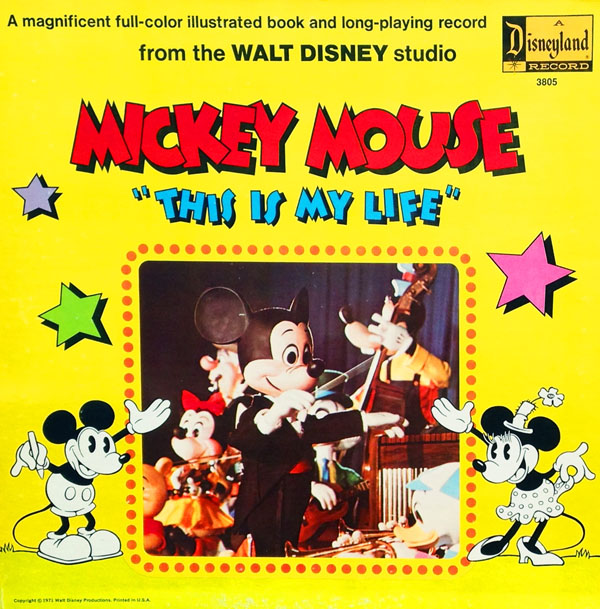
Two attractions were available as record albums when the Walt Disney World opened in 1971 and were also available in retail stores elsewhere. The first LP was not an attraction soundtrack, probably because the music was not licensed for commercial recordings at the time.
Instead, the Mickey Mouse Revue attraction was represented in August 1971, by Mickey Mouse: This Is My Life. When sold in Magic Kingdom, a sticker was added over the shrinkwrap that read “Mickey Mouse Revue.” This also allowed the album to have general salability outside the resort.
As this earlier Animation Spin explains, the photo on the front cover of Mickey Mouse: This Is My Life is a photo of Audio-Animatronics Mickey from the then-new attraction. The “interview” on side one between Mickey and his alter ego at the time, Jimmy Macdonald, culminates with Mickey’s pride in his latest achievement, which was the attraction (misspelled as “Mickey Mouse Review” in the album’s book). In place of the show soundtrack, side two contains a collection of previously released Disneyland Records tracks (film soundtracks and studio versions) stood in the attraction’s program on side two. (In 1980, The Mickey Mouse Revue attraction was moved to Tokyo Disneyland when that park opened in 2009 it closed permanently with some figures now appearing at Epcot in the Gran Fiesta Tour Starring The Three Caballeros attraction.)
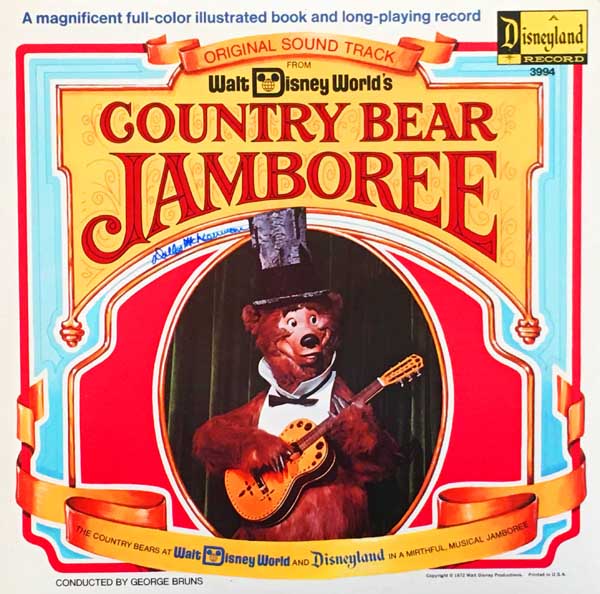
COUNTRY BEAR JAMBOREE
The Original Sound Track of the Walt Disney World Attraction
Disneyland Records – Storyteller Series ST-3994 (12” 33 1/3 rpm / mono)
Released in September 1971. Soundtrack Producer: Jimmy Johnson. Musical Direction: George Bruns, Arthur Norman, Camarata. Running Times: 16 minutes (Country Bear Soundtrack) / 14 minutes (Mile Long Bar).
Country Bear Voices: Pete Renoudet (Henry, Max); Tex Ritter (Big Al); Bill Cole (Wendell); Jimmy Stoneman (Liver Lips); Patsy Stoneman (Teddy Berra); Van Stoneman (Ernest, Terrence/Shaker); Trixie (Cheryl Poole) and The Sun Bonnet Trio: Jackie Ward (Bunny); Bubbles (Loulie Jean Norman); Beulah (Peggy Clark).
Other Voices: Thurl Ravenscroft (Buff the Buffalo); Bill Lee (Melvin the Moose); Bill Cole (Sammy the Raccoon).
Songs: “Pianjo” by Don Robertson; “Bear Band Serenade” by Xavier Atencio, George Bruns; “If You Can’t Bite, Don’t Growl” by Tommy Collins; “My Woman Ain’t Pretty (But She Don’t Swear None)” by Frankie Starr, Paul E. Miller; “Mama, Don’t Whip Little Buford” by Kenneth C. Burns, Henry D. Haynes; “Tears Will Be the Chaser For Your Wine” by Dale Davis, Leroy Goates; “How Long Will My Baby Be Gone” by Buck Owens; “All the Guys That Turn Me On Turn Me Down” Gene Plott, Harold Powell, Roni Stoneman; ”Heart, We Did All That We Could” by Ned Miller; “Blood on the Saddle” by Everett Cheetham; “The Ballad of Davy Crockett” by Tom Blackburn, George Bruns; “Ole Slew Foot’ by Howard Hausey; “Come Again” by Tom Adair, George Bruns.
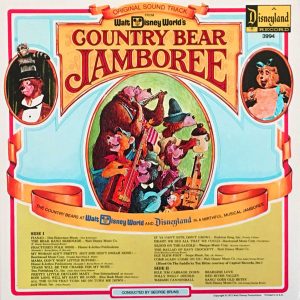 The Audio-Animatronics stage presentation of Country Bear Jamboree, presented for the last fifty years now (with some modifications) in Frontierland at Magic Kingdom Park (as well as at Tokyo Disneyland), was also the first Walt Disney World soundtrack album.
The Audio-Animatronics stage presentation of Country Bear Jamboree, presented for the last fifty years now (with some modifications) in Frontierland at Magic Kingdom Park (as well as at Tokyo Disneyland), was also the first Walt Disney World soundtrack album.
Jimmy Johnson and his executive assistant, Rose Mussi, were instrumental in the selection and research of songs and music for Country Bear Jamboree. This attraction was one of the last personally supervised by Walt with hand-picked talents that included Bill Justice and Marc Davis. The attraction was first developed for the Mineral King ski resort complex, a project that was never to happen due to pushback from the Sierra Club. As Walt says in the “Project Florida” film, “Everything you see in this room will change.” Therefore it’s an exercise in futility to guess “what Walt would have done or thought” today, or whether some things would or would not have come to pass. He didn’t know from day to day, year to year, so how can we?
The musical director for the original show was George Bruns (Sleeping Beauty, The Jungle Book), and the musical director for the other two versions was frequent Walt Disney Imagineering contributor George Wilkins, no stranger to animation as the arranger/conductor for the Rankin/Bass feature The Wacky World of Mother Goose.
 The cast includes some legendary Disney performers and as well as country icons. Walt Disney Imagineering fixture Peter Renoudet (or Renaday) voices Henry, the host of Country Bear Jamboree. Pete’s career is renowned to those who have even a cursory knowledge of Disney, from his numerous roles in Disney live-action films (including the policeman who sees Herbie the Love Bug attempt suicide) and his offscreen singing to countless theme park voices and record albums. During his stint in the script library, he and Julie Andrews exchanged waves as she rehearsed dance sequences for Mary Poppins.
The cast includes some legendary Disney performers and as well as country icons. Walt Disney Imagineering fixture Peter Renoudet (or Renaday) voices Henry, the host of Country Bear Jamboree. Pete’s career is renowned to those who have even a cursory knowledge of Disney, from his numerous roles in Disney live-action films (including the policeman who sees Herbie the Love Bug attempt suicide) and his offscreen singing to countless theme park voices and record albums. During his stint in the script library, he and Julie Andrews exchanged waves as she rehearsed dance sequences for Mary Poppins.
Also in the cast are members of the Stoneman family, singers whose father Ernest was one of the pioneers of country-western music. Tex Ritter, the grandfather of actor John Ritter, sings for Big Al, though it is a previous vintage recording. Hanna-Barbera fans take note that studio singing greats Bill Lee and Jackie Ward are also in the cast—the singing voices of Yogi and Cindy in the feature, Hey There, It’s Yogi Bear.
Since the original Country Bear Jamboree was only a little over fifteen minutes long, side two is graced with George Bruns background music (or in theme park parlance, “BGM”) from Frontierland’s Mile Long Bar counter-service food location next to the attraction. A book illustrated with photos transforms the LP into a “Storyteller.” When the attraction opened on the West coast, the album cover copy was revised to include Disneyland.
Country Bear Jamboree was made into an amiable but not very impactful theatrical feature. The attraction was transformed into two additional versions (Country Bear Christmas Special in 1984 and Country Bear Vacation Hoedown in 1986). A short-lived but delightful musical morning show was presented at Pioneer Hall at Disney’s Fort Wilderness Resort starring one of its characters, The Melvin the Moose Breakfast Show.
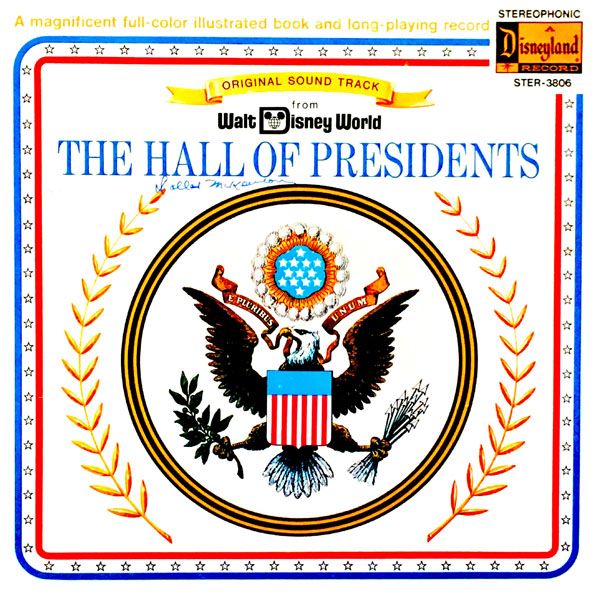
THE HALL OF PRESIDENTS
Original Sound Track from Walt Disney World
Disneyland Records – Storyteller Series ST- 3806 (12” 33 1/3 rpm / mono)
Released in August 1972. Soundtrack Producer: Jimmy Johnson. Writer: James Algar. Music: Buddy Baker. Running Times: 23 minutes.
Voices: Lawrence Dobkin (Narrator); Royal Dano (Abraham Lincoln); Paul Frees (George Washington, Governor Mifflin, Stephen Douglas, Crowd Voices); Dal McKennon (Andrew Jackson).
Song: “Battle Hymn of the Republic” by Julia Ward Howe and William Steffe.
The second Walt Disney World soundtrack album was The Hall of Presidents Storyteller. It was only available in full stereo while the Country Bear Jamboree was only in mono. This was also the case when both albums were released for a brief time in 2010 through the Disney Parks “Wonderland Music” on-demand CD system kiosks. (When Country Bear Jamboree was included in the CD box set, A Musical History of Disneyland, Walt Disney Records Producer Randy Thornton restored its stereo soundtrack.)
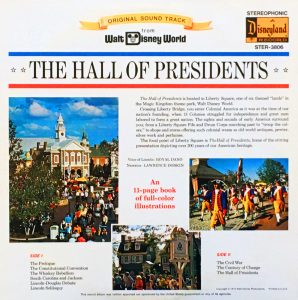 The Hall of Presidents has its musical and visual roots in the 1964-65 New York World’s Fair and Disneyland attraction, Great Moments with Mr. Lincoln. Originally conceived as a Disneyland attraction, it contains music and dialogue lifted for The Hall of Presidents, plus new scoring based on themes from Great Moments. The Lincoln-Douglas debate sequence is an edited version lifted completely from the earlier attraction. The narration by Larry Dobkin and additional dialogue by Dal McKennon (and other uncredited actors) was created for Walt Disney World.
The Hall of Presidents has its musical and visual roots in the 1964-65 New York World’s Fair and Disneyland attraction, Great Moments with Mr. Lincoln. Originally conceived as a Disneyland attraction, it contains music and dialogue lifted for The Hall of Presidents, plus new scoring based on themes from Great Moments. The Lincoln-Douglas debate sequence is an edited version lifted completely from the earlier attraction. The narration by Larry Dobkin and additional dialogue by Dal McKennon (and other uncredited actors) was created for Walt Disney World.
In addition to the soundtracks, two 12-inch picture discs were sold at the resort as well, emphasizing entertainment offerings. A Musical Souvenir of Walt Disney World featured various bands, musicians and vocal groups, recorded live and in studios (some of this album was used on later compilations). The other was called A Musical Souvenir of America on Parade, the electronic soundtrack of the unusual Bicentennial Magic Kingdom parade in which performers wore oversized, Mardi Gras-style heads over their costumes themed to periods in American history.
There was also a seven-inch picture disc for the Walt Disney World Electrical Water Pageant, (precursor to the Main Street Electrical Parade), and a wonderful little flexi-disc called The Walt Disney Character Parade with a song played for the renowned “three o’clock parade” that was also used for a regional Walt Disney World TV commercial.
Soon other park-related vinyl albums appeared in Walt Disney World shops: a storyteller based on the first Walt Disney World animated character, The Orange Bird; two Disneyland/Walt Disney World compilation LPs, an Official Epcot album, and an album of songs by Voices of Liberty, the a Capella Epcot vocal group. Occasionally a record on a non-Disney label would be also offered in park and resort shops, including one by the Adventureland Steel Drum Band.
General Electric Show ‘n Tell: Walt Disney World
Just for “goofy” fun, here’s “Mickey Mouse” (cough, cough) narrating a whirlwind tour of the entire Walt Disney World resort as it was in the early seventies. This was part of a record and filmstrip set for Show ‘n Tell, introduced by G.E. and later produced by Gabriel and Child Guidance. In those pre-video days, kids would slide the plastic filmstrip into the top of the TV-like viewer and play the record on top. The pictures would change on the lighted screen as the turntable moved the filmstrip up and out of the slot.


 GREG EHRBAR is a freelance writer/producer for television, advertising, books, theme parks and stage. Greg has worked on content for such studios as Disney, Warner and Universal, with some of Hollywood’s biggest stars. His numerous books include Mouse Tracks: The Story of Walt Disney Records (with Tim Hollis). Visit
GREG EHRBAR is a freelance writer/producer for television, advertising, books, theme parks and stage. Greg has worked on content for such studios as Disney, Warner and Universal, with some of Hollywood’s biggest stars. His numerous books include Mouse Tracks: The Story of Walt Disney Records (with Tim Hollis). Visit 






















































This brings back a lot of memories. It is hard to believe that WDW opened 50 years ago when I can remember it so vividly (and I honestly don’t feel old enough to be someone who can remember fifty years back). I eagerly obtained each one of the Disneyland albums referenced above and they brought me hours of delight. As our family lived on the west coast, a visit to WDW was only a dream in those days, although I have visited since as an adult. So the records were the only way I could experience the “magic” of the WDW Magic Kingdom.
At first I figured that the Country Bear Jamboree would be limited to Florida, so I was delighted to discover that it had been established at Disneyland as well, so that I could eventually see it. One of my biggest all-time disappointments about Disneyland was the closing of this attraction. To this day I have a hard time warming up to the Winnie-the-Pooh ride that replaced it because to my thinking the Bear show was superior in every way, It was aimed at a family audience, whereas the Pooh ride is geared specifically for little kids. It’s cute and charming, but the Country Bears had more to offer on every level. Plus I would rather see a show than ride a ride any day, but that’s me. At least we have the soundtrack preserved for posterity.
The Hall of Presidents album, even though it bore more than a passing resemblance to the Mr. Lincoln album which preceded it by several years, was another eagerly anticipated purchase. It’s unfortunate that the attraction focused almost exclusively on Lincoln since he had already been featured at Disneyland, but the album does include some nods to other presidents and other events. It was nice that eventually current presidents were allowed to speak as well as Lincoln. I would love to find an updated version of this sound track.
Speaking of the Presidents album, I did want to point out one thing. You wrote: “The narration by Larry Dobkin and additional dialogue by Dal McKennon (and other uncredited actors) was created for Walt Disney World.” One of these other uncredited actors on the Presidents album was Paul Frees, who voices several historical personages. His distinctive voice is always used to good effect in Disney films and attractions. In this instance he voices Benjamin Franklin, and if I remember correctly, George Washington and Andrew Jackson as well, and some incidental voices.
Thanks as always for a delightful post that brings back such fond memories.
Thanks, Frederick, I am adding in credits for the album that include the voices done by Dal and Paul Frees. I have always wondered who voiced Benjamin Frankiin and speculated that it was someone on the Disney staff, perhaps a veteran of the Walt days.
Totally agreed, F.W., in every w\ay, as someone who grew up also on the west coast, but in 1995, almost 25 after the 1971 opening of WDW/Magic Kingdom ’71, fianlly went there, and was very impressed (“IT’S A SMALL WORLD” & “PIRATGES..”,as with many others, underwhelmed me conp[ared to their locala west coast counterparts..) I also loved Country Bears more thna the Pooh ride, despite VERY IMMENSELY a POOH fan..always great to hear from ou and the others.,
My apologies. I was mis-remembering when I said Paul Frees voiced Franklin. But I remembered that he did provide some voices on the album. So I appreciate the credits given. I’m so glad these albums got some mention on this post, and it is always great to see those covers.
Walt Disney’s original concept of Epcot is strikingly similar to the Australian capital city of Canberra, coincidentally designed by a Chicago-born American visionary named Walter, architect Walter Burley Griffin, who very self-consciously sought to create an “ideal city of the future”. Whatever the benefits of a radial city plan — and offhand I can’t think of any — I assure you that Canberra is a very easy city for out-of-towners to get lost in. No matter where you try to go, you wind up driving in circles around Parliament House. There aren’t any Wed Ways, either. Everyone who lives there rides a bicycle.
I remember watching the Space Mountain Grand Opening special when it first aired. My brother, then a sarcastic 15-year-old, kept a very funny commentary going throughout the proceedings, mostly about Tommy Tune’s wardrobe and the people in the background mugging for the camera. Space Mountain itself was necessarily anticlimactic, since the thrill of riding an indoor roller coaster in the dark is impossible to convey to a television audience. We were very disappointed. Observing that the special was probably designed to get kids to beg their parents to take them to Disney World, my brother started histrionically begging ours not to. “PLEASE don’t take us to Space Mountain! Anything but Space Mountain!” They never did, but they probably didn’t need any urging; it was just too expensive and too far away. In fact, to this day I’ve never set foot in any of the Disney theme parks. Too bad. I hear they’re pretty good.
Watching Walt’s original plans for Disney World, it’s interesting to compare to what was actually built. Some of the ideas got there in some form (Celebration, Disney Springs), but a lot of what Walt had in mind probably wouldn’t have been practical on that grand a scale. Still would have been cool, though.
I remember the Delta ride well, especially that song. It was always my mother’s favorite. Everything that replaced it has been a let down.
On my last visit to Disneyland, just before Galaxy’s Edge opened, the one AV souvenir I found was a Haunted Mansion CD. No DVDs, LPs, cassettes, VHS tapes, or 8mm reels. Most of the content is available outside the parks, of course — I’ve got Date Night at Disneyland on my iPod, along with other audio keepsakes. But I miss the physical media.
It was as if the Hershey theme park didn’t sell chocolate.
Great article on the early music of Walt Dated World. One thing you may find interesting is that the Character Parade music was later modified for Mickey’s 50th Birthday Parade in 1978 and was even used (with more modified lyrics) in a VHS “Disneyland Fun” sing a long tape from 1990. The second half of the birthday parade featured a song that was also recorded by Davy Jones of the Monkees! My Walt Dated World website has a picture of his 45 of that song.
One small thing-the Country Bears were never at Disneyland Paris. They are in Tokyo Disneyland.
Thanks for catching that about Tokyo — we will correct it. I appreciate all the hard work you do to account for the original names of the locations around Walt Disney World, as so many of us remember being there at different times. Just like Animation Spin though, I’m sure that as complicated as it can get, it’s a labor of love.
Another amazing column, Greg.
As you may recall, Dal McKennon used to stay at my house when he was in town.
On one of his last visits he was flown down to reprise his role of Benjamin Franklin for some park project.
He was proud of the fact that he was doing a character he’d first done for Disney’s decades before.
I can’t recall how long the session was, It may have been just a few pick-up lines, . . .but I drove him to and fro and waited in the lobby while he recorded, etc…
Miss the guy.
Thanks for writing, Will, and thanks for reading!
With the help of Tim Hollis and Jim Hollifield, Dal was able to visit Florida for his one and only Walt Disney World visit a few years back, where he wept as he saw The American Adventure and The Hall of Presidents for the first and last time. Thanks to American Adventure attraction host Lonnie Hicks, he was fitted with a Ben Franklin outfit. Guests that day were given the once-in-a-lifetime chance to have the show introduced by Dal himself in person.
He also rode Thunder Mountain and appeared at Disney University, where I presented a video just a few of his voice acting performances.
Dal got to know my family during that week. He still did his Archie voice, talked of the next Gumby project he hoped to do with Art Clokey, or his “Rainbow Tree” idea. Artists just want to keep on creating. What a treasure to have had this opportunity. We still talk about it to this day. Dal was an unforgettable character and his range of talent touched untold millions–still does.
(By the way folks — don’t miss Will Ryan’s snappy new podcast with Katie Leigh, “Tell Ya Later” on the You Tube.)
I have vivid memories of coming home from my first visit to Disney World in the mid-70’s with the Haunted Mansion LP in tow. Sadly, it was “loved to death” sometime in the early-80’s, along with the very different 7″ Mansion book and record. During the past few years, I’ve been trying to collect as many of the park-related albums as possible because they are just such wonderful time capsules. I’ve been able to find many of the records, including another copy of my beloved Haunted Mansion LP, but there are a few that remain elusive, either due to simply not finding copies for sale or because the copies that are out there have skyrocketed in price. The Pirates of the Caribbean LP is typically going for much more than I’m able to pay for it. I’d also like to get a copy of the Tokyo Disneyland album, but shipping costs from Japan prevent that for the time being.
In any case, thanks so much for this wonderful overview. Walt Disney World of 1971-1985 definitely lives on in my heart, if not in Florida.